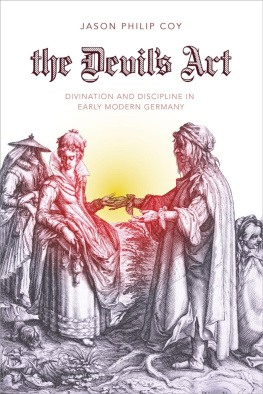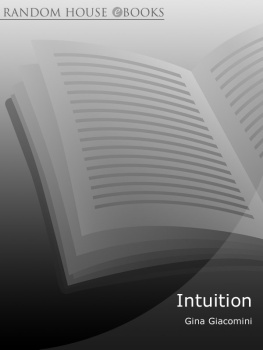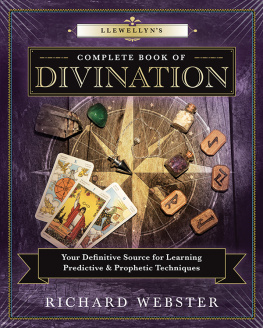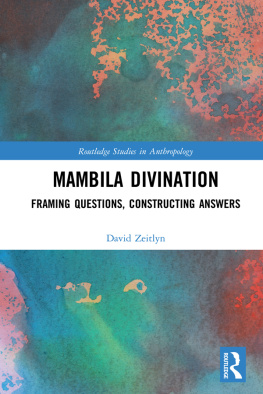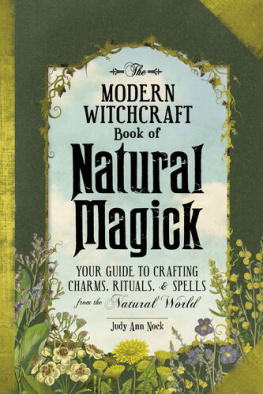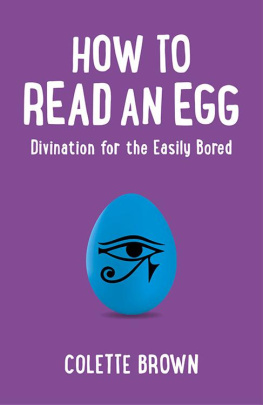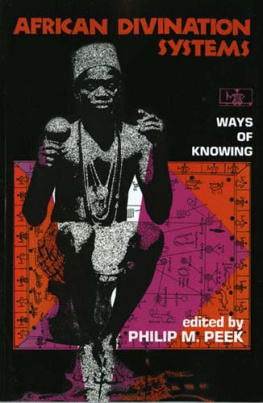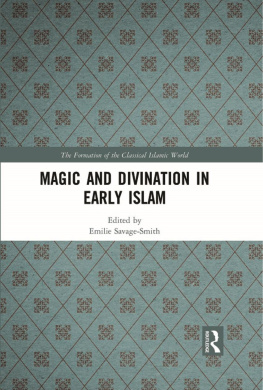The Devils Art
Studies in Early Modern German History
H. C. Erik Midelfort, Editor
Jason Philip Coy
The Devils Art
Divination and Discipline in Early Modern Germany
University of Virginia Press
Charlottesville and London
University of Virginia Press
2020 by the Rector and Visitors of the University of Virginia
All rights reserved
First published 2020
Library of Congress Cataloging-in-Publication Data
Names: Coy, Jason Philip, author.
Title: The devils art : divination and discipline in early modern Germany / Jason Philip Coy.
Description: Charlottesville : University of Virginia Press, 2020. | Series: Studies in early modern German history | Includes bibliographical references and index.
Identifiers: LCCN 2019047978 (print) | LCCN 2019047979 (ebook) | ISBN 9780813944074 (hardback) | ISBN 9780813944081 (epub)
Subjects: LCSH: DivinationGermanyHistory. | Lutheran ChurchGermanyHistory.
Classification: LCC BF1773.2.G67 C56 2020 (print) | LCC BF1773.2.G67 (ebook) | DDC 133.30943dc23
LC record available at https://lccn.loc.gov/2019047978
LC ebook record available at https://lccn.loc.gov/2019047979
Cover art: The Fortune Teller and the Lady, engraving, after Jacques de Gheyn II. (The Elisha Whittelsey Collection, The Elisha Whittelsey Fund, 1949, The Metropolitan Museum of Art)
Contents
I first decided to write a book about divination in early modern Germany a decade ago. Searching for primary sources to use in a seminar on the European witch-hunts I was teaching at the College of Charleston, I noticed that many of the most famousor rather infamousdemonological treatises of the era condemned fortune-telling in addition to witchcraft. Most of the scholarship in the field failed to mention that the eras most ardent witch-hunters were so deeply concerned with fortune-telling, however. Despite the prominence of divination in works by famous demonologists like Heinrich Kramer and Jean Bodin, scholars more interested in witchcraft had largely neglected this aspect of their treatises. As I continued my research, I found that prominent theologians like Thomas Aquinas, Martin Luther, and John Calvin also denounced divination. Learned attacks on popular fortune-telling outlasted the witch hunts, and Enlightenment-era luminaries ridiculed it as an ignorant superstition throughout the eighteenth century. Visiting American research libraries and German archives over the next few years, I set out to answer a number of questions: why were early modern authorities so opposed to divination? Why did Lutheran reformers seem particularly concerned about the popular forms of fortune-telling practiced by the unlearned? Did secular authorities in Germany respond to the clergys call to eradicate popular forms of divination? Why did Reformation-era reformers and Enlightenment-era intellectuals face such difficulty in rooting out these occult practices?
The research and writing of this book took many years, but finishing it has been bittersweet. While working on this project, I experienced a life-shattering personal tragedy, and its completion is a reminder of how much my life has changed in the last ten years. I began my research with the loving encouragement of my wife, Amy, who had supported my scholarship ever since I was a graduate student. As I was finishing my research for this book, Amy was diagnosed with terminal cancer. She passed away in 2016. We had been happily married for 19 years when I lost her. I felt my life unraveling just as I began a sabbatical year in which I intended to complete the manuscript of this book. With the support of caring colleagues and friends, I threw myself into my writing, and finishing this book provided me with a renewed sense of purpose as I began to rebuild my life. Thus, I am doubly grateful for the many people and institutions who have helped me complete this book, since its completion represents both a milestone in my career and in my own personal healing.
I would like to thank a number of institutions that supported my research for this project. I conducted preliminary research in Duke Universitys David M. Rubenstein Rare Book & Manuscript Library in 200910, research funded by an Eleanore and Harold Jantz Fellowship from Duke. I am grateful for this crucial early support. I also made three summer archival research trips to Germany, with funding support from a 2011 Deutscher Akademischer Austauschdienst (DAAD) Re-Invitation Grant, a 2012 Herzog Ernst Fellowship of the Fritz Thyssen Foundation from the Forschungszentrum Gotha, and a 2013 College of Charleston Faculty Research and Development Grant. This project would have been impossible without these generous research grants. Archivists in Erfurt, Weimar, and Gotha have been crucial during these summer research visits, especially Rosemarie Barthel of the Landesarchiv Thringen-Staatsarchiv Gotha. I completed and revised the manuscript while on a yearlong sabbatical from the College of Charleston during the 201617 academic year, and I thank my home institution for this support. I would also like to thank Berghahn Press for their gracious permission to reprint material from an essay I contributed to a 2014 volume I coedited with Benjamin Marschke, Jared Poley, and Claudia Verhoeven entitled Kinship, Community, and Self: Essays in Honor of David Warren Sabean.
I have also accrued a number of personal debts during the years that I worked on this book. A great many friends and colleagues helped me as I started researching this project and began to formulate my early thoughts on the subject. The director and faculty at the Forschungszentrum Gotha were pivotal in helping me refine my topic during my research in Thuringia, especially Martin Mulsow and Alexander Schunka. Others have provided valuable feedback as I presented early versions of these chapters at conferences over the years. Some, like Tom Robisheaux, Ed Bever, Johannes Dillinger, Michael Bailey, Laura Stokes, and Kay Edwards, have enhanced my understanding of magic and witchcraft in early modern Europe. Others, like David Luebke, Mary Lindemann, Joel Harrington, and Sigrun Haude, have enriched my knowledge of early modern Germany.
My greatest thanks go to those who read early versions of the manuscript, providing me with invaluable advice on how to improve it. My department chair, Phyllis Jestice, busy working on her own study of Ottonian female rulership, met with me every other week during my sabbatical to discuss chapter drafts over expensive craft beers (and usually picked up the tab). She not only provided me with valuable feedback, but also encouraged me to keep writing at a steady pace during a turbulent time in my life. Three dear friendsDavid Sabean, Jared Poley, and Robert Davisread through the entire manuscript once it was done and offered me advice on final revisions before I sent it to the press for review. I am grateful for their helpful suggestions. I owe a special debt of gratitude to Erik Midelfort, who supported this project from the very beginning and offered a wealth of sage counsel as I worked to revise the manuscript for publication. The anonymous readers selected by the University of Virginia Press provided me with invaluable advice about how to restructure my manuscript, and they also have my thanks. Finally, I want to thank Leah Worthington for helping me enliven my writing and, more important, for showing me how to be happy again.
The Wise Man of Ohrdruf (1671)
In the summer of 1671, a stranger entered Ohrdruf, a village on the edge of the Thuringian forest. The villagers immediately took note of the planet book he carried, an astrological almanac that marked him as a soothsayer. For the villagers, the wise mans strange book promised an opportunity to glimpse into their futures. One of them, Hans Karst, invited the wise man to his house. Many of Karsts neighbors gathered, eager to have their fortunes told. For the price of a mug of beer, the stranger agreed. One by one, he gazed into the villagers eyes and offered them each a prediction about their future. Mostly, he warned them about threats they must avoid, including the threat of witchcraft. With the region in the grips of a violent outbreak of witch-hunting, bewitchment was a concern on the minds of many Thuringian villagers. One of the women present asked the wise man to read her palm in order to confirm for her neighbors that she was not a witch, but he refused. After the woman left, however, the fortune-teller warned his host, Karst, that she was indeed a witch. He also cautioned that she wanted to harm the villager with her hexes. As a result, Karst began calling the woman a witch in public. Her husband, in turn, sent a letter to the ducal officials in Gotha complaining about the slanderous accusation. With the duchy in the midst of a gruesome witch-hunt, rumors of witchcraft prompted an official investigation that brought the soothsayers shadowy activities to light.

